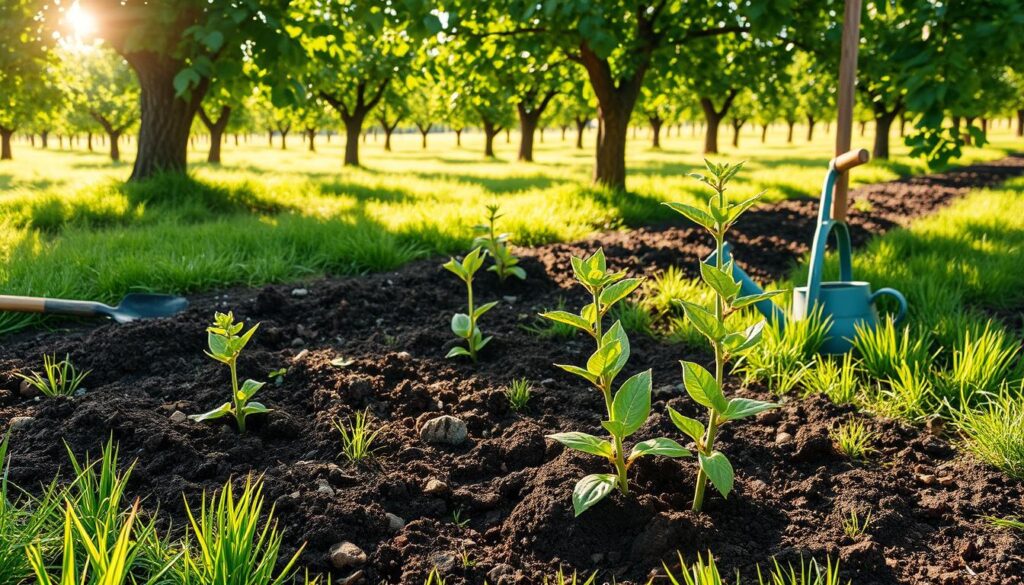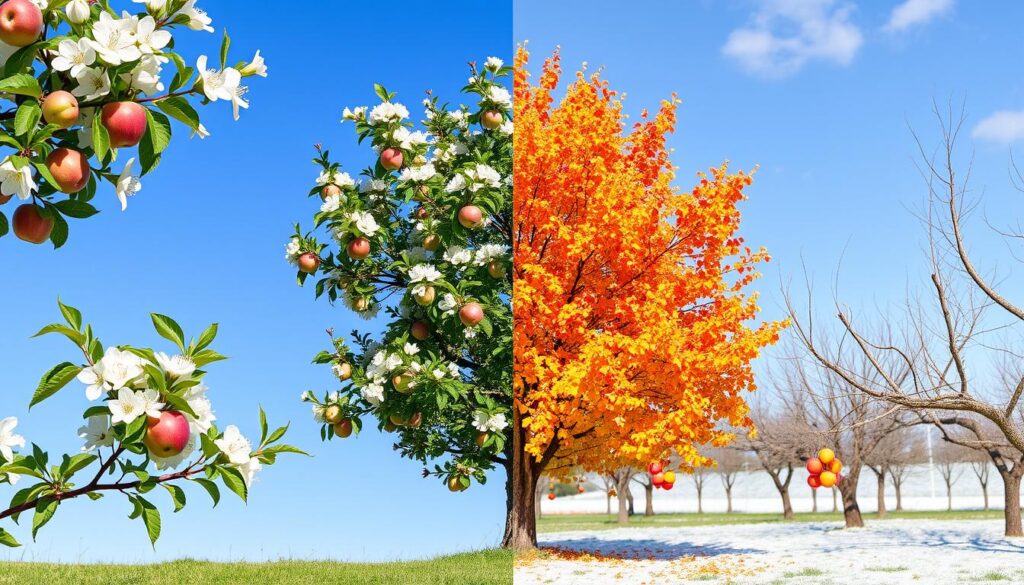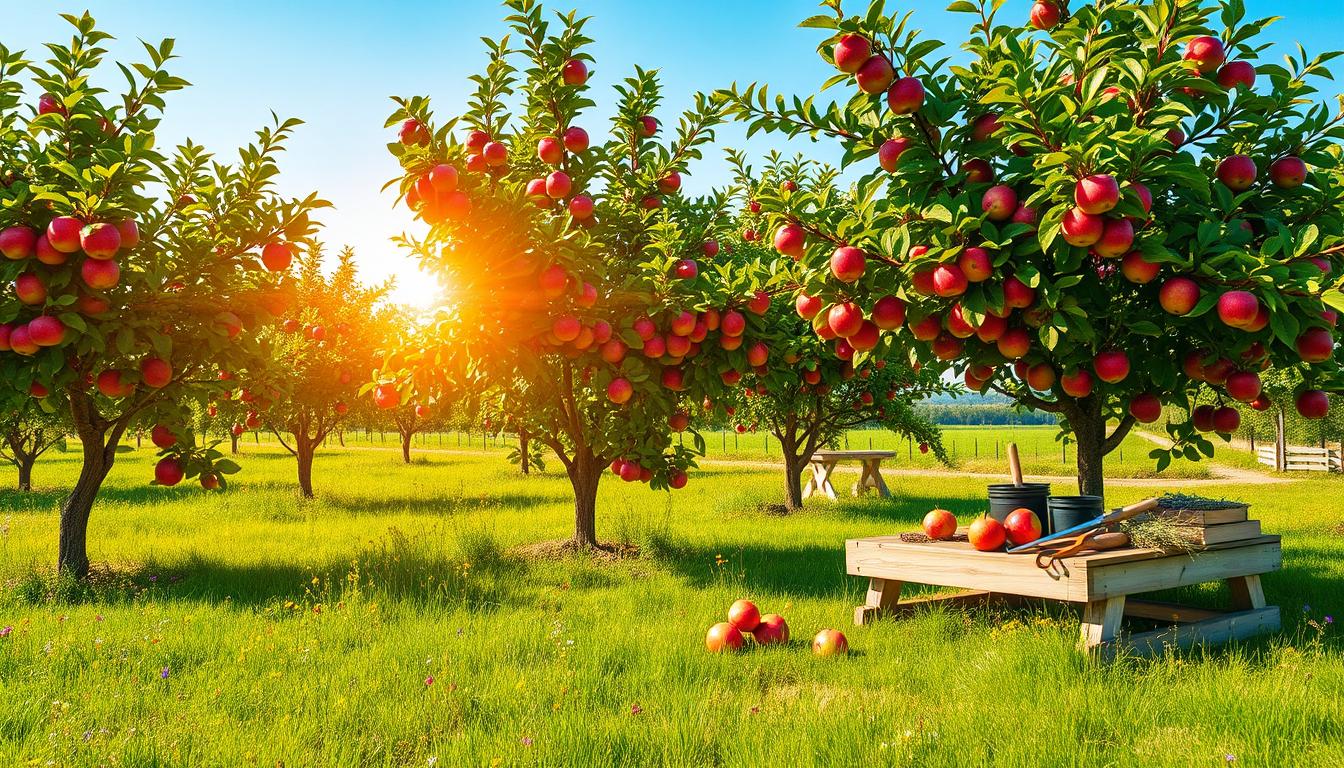Ever dreamed of picking fresh apples from your backyard? This Ultimate Guide to Growing Apples at Home is for you. It offers the key knowledge and techniques to grow apples with ease. With over 7,000 apple varieties worldwide, growing your own can be thrilling and rewarding.
By learning the right cultivation techniques, choosing the best varieties, and creating the perfect growing conditions, you can grow thriving fruit trees. My guide will help you, whether you’re new to gardening or have lots of experience. We’ll cover pollination, pest management, and more.
Imagine picking 200 to 500 pounds of delicious apples every year from one tree. It’s possible with the right approach! Let’s explore the world of apple growing together and make your dream of a lush apple orchard come true.
Key Takeaways
- Over 7,000 apple varieties can be successfully grown at home.
- Apple trees can yield between 200 to 500 pounds of fruit each year.
- Site selection is key; fruit production thrives in mild, warm weather.
- Understanding soil and watering needs ensures healthy apple tree growth.
- Effective pest and disease management is crucial for apple tree health.
- Proper timing for planting and harvesting significantly impacts yield.
- Regular maintenance and pruning improve overall tree health and fruit quality.
Why Grow Apples at Home?
Growing apples at home brings many benefits of growing apples that make gardening better and improve my life. These trees give me fresh, organic apples right in my yard. They taste better and are more nutritious than store-bought apples.
Having a home apple orchard is very rewarding. I can grow different types of apples and enjoy them all year. Dwarf trees start producing apples in 2 to 3 years, while standard trees take up to 8 years. Just a few trees can give enough apples for my family and friends.
Caring for apple trees connects me to nature and promotes green gardening. It also cuts down on the carbon footprint from long-distance fruit transport. Plus, it makes me happy to prune, water, and watch the trees grow.
Apple trees are easy to care for. They need sunlight, water, and space to grow well. They need at least 8 hours of sunlight a day and about an inch of water a week from May to October.
| Factor | Requirement |
|---|---|
| Sunlight | At least 8 hours daily |
| Water | 1 inch weekly (May – October) |
| Soil pH | 6 to 7 |
| Dwarf Tree Height | 8 to 15 feet |
| Standard Tree Height | Up to 20 feet |
| Tree Spacing (Dwarf) | 6 to 8 feet apart |
| Tree Spacing (Standard) | 20 to 25 feet apart |
Keeping a home apple orchard is fulfilling. It lets me harvest fresh apples and feel proud of growing my own food. Growing my own apples is a great choice.
Choosing the Right Apple Varieties for Your Home Orchard
Choosing the right apple varieties is key for a thriving home orchard. The best ones should match your taste and the local climate. For example, Honeycrisp and Liberty apples are favorites for their taste and disease resistance.
When picking apple trees, think about their size. Dwarf trees, about 8 to 10 feet tall, are great for small spaces. They can give you 1.5 to 3 boxes of apples. Semi-dwarf trees, 15 to 20 feet tall, can produce 4 to 7 boxes. Columnar trees are perfect for tight gardens, growing only 10 feet tall and 2 to 3 feet wide.
The location of your trees is also important. They should be within 100 feet of each other for good pollination. Also, check the planting zone for each variety. For example, Liberty trees are good for areas needing disease resistance, while Red Delicious trees do well in zones 4-7.
Hosting apple tasting events is a fun way to try different flavors. You can find everything from citrusy to nutty tastes. To learn more about picking the right apple varieties, check out this informative article.
| Apple Variety | Ripening Time | Characteristics | Best Growing Zones |
|---|---|---|---|
| Honeycrisp | Late September | Large, juicy, crisp | 4-8 |
| Liberty | Late September | Medium-sized, red, crisp | 4-8 |
| Pristine | Early August | Yellow skin, firm, crisp | 4-8 |
| Jonagold | October | Large yellow with red blush | 5-9 |
| Granny Smith | Late October | Tart, green, crisp | 5-9 |
Understanding Apple Tree Pollination Needs
Apple tree pollination is key for a good harvest. Many apple trees need cross-pollination to produce fruit. Planting different apple tree varieties close to each other helps a lot.
It’s best to plant trees within 100 feet of each other. This distance lets bees and other pollinators move pollen easily between trees.
Choosing the right trees is important. Apple trees bloom at different times. They fall into five bloom periods: early, early-mid, mid, mid-late, and late.
Early-blooming trees can match mid-season ones. Mid-season trees might also match late-blooming ones. This ensures pollination throughout the season.
Crabapple trees are great pollinators. Many orchardists use them for better pollination. Some apple varieties, like Jonagold and Bramley Seedling, need cross-pollination because their pollen is sterile.
Using pollen charts from nurseries can help find the right partners for your trees. These charts show which varieties bloom together. This ensures cross-pollination.
Remember, growing apple trees takes time. They usually take 2-5 years to start producing fruit.
To get the best apple yields, know your trees’ needs and how different varieties work together. Paying attention to these details will help you have a successful harvest.
Site Selection: Finding the Perfect Location for Your Apple Trees
Choosing the right spot for apple trees is key for their health and growth. Knowing what your trees need helps your orchard thrive. The best spot should get at least 6 to 8 hours of direct sunlight for apple trees daily. This light is vital for fruit growth and tree health.
When picking where to plant, keep in mind the tree type:
| Type of Apple Tree | Recommended Spacing |
|---|---|
| Dwarf | 8 to 10 feet |
| Semi-Dwarf | 12 to 15 feet |
| Standard | 18 to 20 feet |
| Columnar | 2 to 3 feet |
Make sure the area is frost-free and drains well. Good air flow helps avoid diseases. Test your soil before planting to adjust pH levels, aiming for 6.0 to 7.0. Sandy loam or loam soils are best for roots.
To help trees pollinate each other, plant them 100 feet apart. Self-pollinating types like Golden Delicious Apple and Grimes Golden Apple can do well in small spaces. You might want to check out more resources on starting and managing an orchard.
The Ultimate Guide to Growing Apples at Home
Many factors affect apple growth. Knowing these can greatly improve your harvest. Soil quality, sunlight, and climate are key. These elements help apple trees grow and produce fruit.
For those growing apples, paying attention to these factors is crucial. It’s important for anyone interested in growing apples at home.
Essential Factors for Successful Apple Growth
Apple trees do best in well-drained soil with a pH of 6.0 to 7.0. They need full sun, at least 6 to 8 hours a day. The tree’s size also matters, ranging from 6 to 30 feet tall.
Knowing these factors helps choose the right trees for your orchard. It’s important for a successful harvest.
How Climate Affects Apple Cultivation
The climate is very important for apple trees. They need cold winters, moderate summers, and medium to high humidity. Chill hours, from 500 to 1,000, are also crucial for flowering and fruiting.
For example, Gala apples need only 500 chill hours. Local climate conditions affect the growth stages of apple trees. Understanding these climate aspects can improve your harvest.
If you want to learn more about apple growth, check out privacy policies on gardening resources.
Planting Your Apple Trees
Growing apple trees well needs the right planting practices. Knowing when to plant apple trees is key for their growth and fruit. The best planting times vary by tree type and local weather. I like to plant dormant trees in late winter or when the soil is ready. Potted trees are also an option, available all year.
Best Times for Planting Apple Trees
Timing is crucial for apple tree health. Here are some important points:
- Dormant trees do best in late winter or early spring.
- Potted trees can be planted anytime, but need apple tree planting preparation for best results.
- Planting should match the local frost date to protect young trees.
Preparing the Planting Site
Good site preparation is key for planting apple trees. Follow these steps for healthy roots:
- Dig holes wide enough for roots to grow, but not deeper than the root ball.
- Blend native soil with organic matter to improve soil quality.
- For container trees, check the roots, untangle any circling ones for better growth.
- Make sure the soil drains well to avoid root damage from water.
After planting, water well to fill air pockets and help roots grow. With careful planning and care, my apple trees will flourish and give tasty fruits for years.

Apple Tree Care: Watering and Soil Needs
Caring for apple trees means knowing their soil and watering needs. This knowledge is key for their growth and fruit. I’ve learned that focusing on apple tree soil needs and watering methods for apple trees greatly improves their health.
Understanding Soil Requirements for Apple Trees
Apple trees do best in well-drained, slightly acidic soil with a pH of 6.0 to 6.8. It’s important to ensure the soil has enough nutrients. Adding organic matter, like compost, helps a lot. Regular soil tests also help keep nutrients balanced, as apple trees need iron, zinc, magnesium, and more for growth.
Watering Techniques for Healthy Growth
Proper watering is crucial for apple tree care. Younger trees need water 2-3 times a week, especially in their first year. Sandy soil needs water twice a week, while clay soil only needs it once. Mature trees should get at least an inch of water weekly.
One effective way to water is by letting a hose trickle slowly around the roots. This helps water soak in better and promotes root growth.
Mulching helps keep moisture in and weeds out, which is good for the tree and soil. It’s important to adjust watering based on weather and local rules. For more tips on caring for apple trees all year, see this guide.
Pest and Disease Management for Apple Trees
Keeping apple trees healthy is key to a good harvest. They face many pests like codling moths and diseases like apple scab. Knowing these threats helps use the best organic pest control.
Common Pests That Affect Apple Trees
It’s important to watch for pests on apple trees. Here are some common ones:
- Aphids
- Apple Maggot
- Bud Moth
- Codling Moth
- Borers
- Gypsy Moth
- Japanese Beetle
- Leafhopper
- Leafroller
- Mites
- Plum Curculio
- Red Bug
- Scale
- Tarnished Plant Bug
- Tent Caterpillar
- Thrips
To fight these pests, I use organic solutions like Monterey Horticultural Oil. Keeping the area clean also helps.
Organic Solutions for Pest Control
For organic pest control, I use several methods and products:
| Pest | Recommended Control Measures |
|---|---|
| Aphids | Monterey Horticultural Oil |
| Codling Moth | Entrust |
| Apple Maggot | GardenTech® Sevin® Concentrate Bug Killer |
| Scale | Naturally, use horticultural oil during dormancy. |
| Apple Scab | Preventative measures include sulfur treatments during susceptible growth stages. |
Using these methods helps control pests and diseases. Regular updates and integrated pest management keep my trees healthy.
Apple Tree Maintenance Throughout the Seasons
Keeping apple trees healthy all year is key for good growth and lots of fruit. Each season has its own tasks to keep the tree in top shape. By doing these tasks, I make sure my apples are the best they can be.
In spring, caring for apple trees starts with pruning. This lets air and sunlight in, fighting off diseases. I also give my trees a boost with fertilizer. A soil test helps keep the pH right for nutrient absorption.
Summer is all about watering and sun. I make sure my trees get about an inch of water a week and eight hours of sun. I also keep an eye out for pests and diseases to catch them early.
Autumn means watching for pests and cleaning up leaves and bad fruit. This stops pests from staying over winter. I also mulch and use tree guards to protect the trunks. This gets my trees ready for winter.
Winter brings its own set of challenges. I watch out for wildlife that might harm young trees. Taking care of my trees in winter makes them stronger. Regular care means my trees will grow well and give me plenty of apples.

Harvesting Your Homegrown Apples
Harvesting apples is a thrilling part of growing them. It’s important to know when to pick them for the best taste and quality. Each type of apple has its own best time to pick, shown by its color and taste.
Determining the Right Time to Harvest
Figuring out when to pick apples isn’t just about the date. Popular types like Granny Smith, Honeycrisp, and Fuji have special signs of ripeness. I found that checking the apple’s color and firmness is key. Many also suggest tasting them to make sure they’re sweet enough.
Weather also matters, especially in areas where apple trees grow well. Depending on the apple, you should watch them closely as they get ready to be picked.
Best Practices for Picking Apples
To get the best apples, follow some important picking tips. I learned to pick them carefully, twisting them off the tree to avoid damage. For apples out of reach, using special tools is helpful.
After picking, I kept my apples in a cool, dark spot to keep them fresh longer. Keeping the area around the trees clean helps prevent diseases and pests.
Looking back, I’ve learned a lot about picking apples. Timing and care are crucial. For more on farming practices, check out this resource.
Conclusion
Growing apples at home is more than just enjoying fresh fruit. It’s a rewarding experience that connects us to nature. This guide helps ensure my apple trees stay healthy and productive. This way, I can enjoy the many benefits of growing apples at home.
Every step, from picking the right varieties to understanding their needs, is crucial. It helps me develop successful apple cultivation practices. This journey shows me the importance of caring for my trees over the years.
Apple trees can live for 15 to 30 years. This means I need to care for them properly. With patience and following the guide’s advice, I can grow a thriving orchard. This orchard will give me delicious apples and make my gardening more rewarding.
If I have any questions or need help, I can contact a Contact page for resources. In the end, growing apples at home brings joy and satisfaction. By understanding each variety’s needs and providing the right conditions, I’m on my way to a bountiful harvest every year.



Leave a Reply